Table of Contents
Sleeve tattoos are much more than an aesthetic statement; they’re a commitment. They’re about telling your story, wearing your heart, dreams, fears, and beliefs on your skin, quite literally. It’s akin to turning your body into a walking art exhibition, showcasing the chapters of your life. Sounds interesting, doesn’t it?
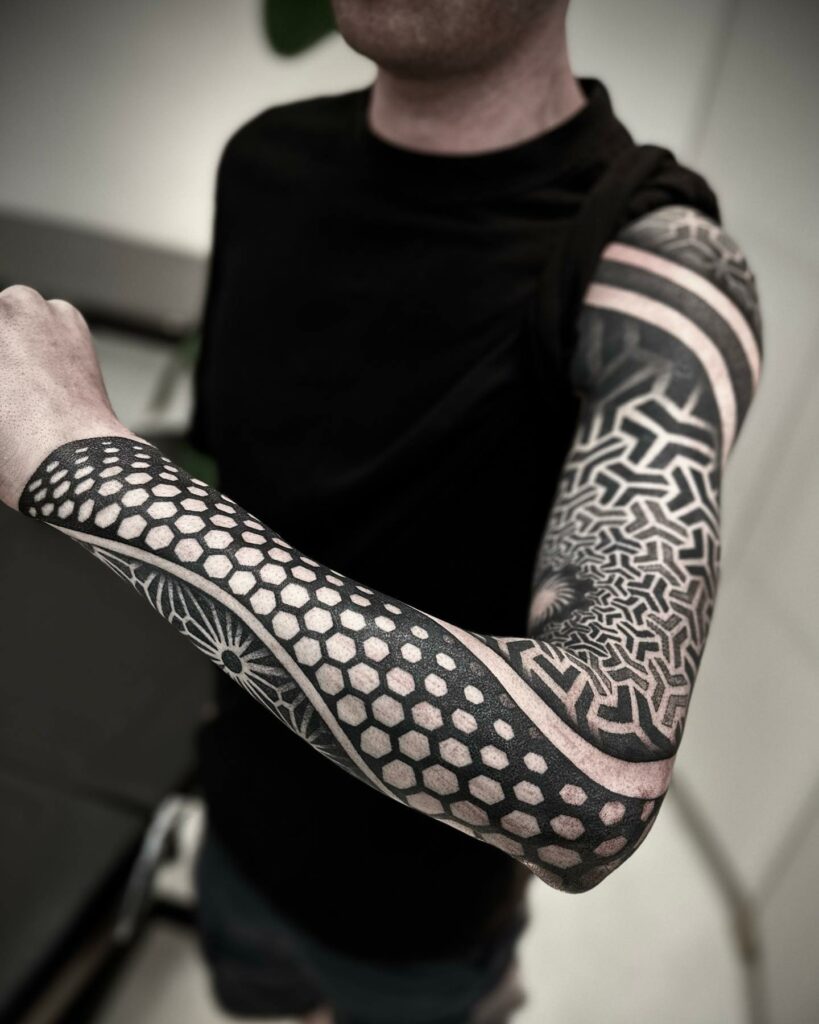
In this post, we’ll be stitching together everything you need to know before you decide to get your arm all dressed up in ink. We’ll dive into the process, the time commitment, the impact on your wallet, aftercare, and how to choose a design that whispers the narrative of your soul. We’ll even throw in some of my personal anecdotes, experiences, and pro tips to make this journey just a little bit easier for you.
I’ll be your tattoo-sherpa, guiding you up this artistic mountain, ensuring you’re prepared for the climb, and answering any burning questions (no, not the needle burn!). But remember, every tattoo is as unique as the person wearing it, so while I’ll be providing a roadmap, your journey will be uniquely yours.
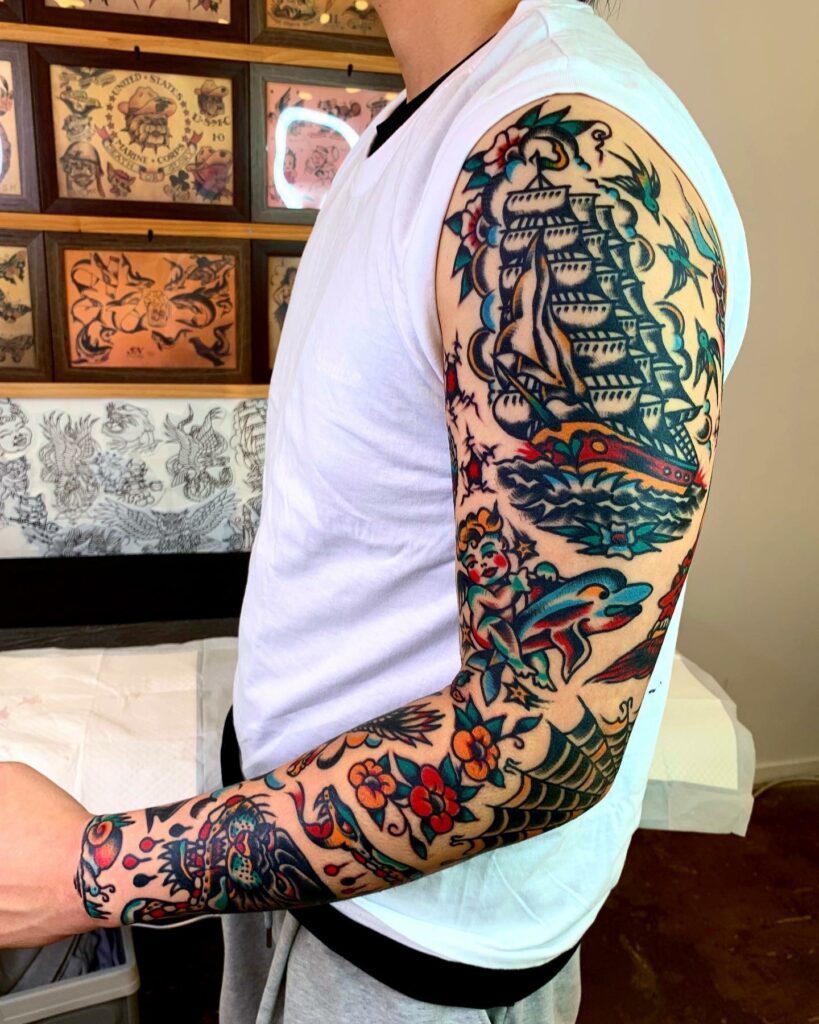
What You Need to Know Before Getting a Sleeve Tattoo
Sleeve tattoos require detailed planning and can’t be chosen like picking a random image from an Internet search. If you don’t want to wear a design that prompts a reconsideration of life choices, then thorough research, theme exploration, and artist selection are paramount. We’ll guide you through this labyrinth, unraveling the process, expectations, and post-tattoo care.
4 Types of Sleeve Tattoos
Let’s start by navigating the broad landscapes of sleeve tattoos:
- Quarter Sleeve: Like a short story, it covers the journey from your shoulder to halfway down your elbow.
- Half Sleeve: Extending the narrative from shoulder to elbow, it offers a bit more room for storytelling.
- Full Sleeve: An epic from shoulder to wrist, a grand canvas for the ambitious.
- Hikae: An exotic Japanese-style sleeve tattoo, it ventures into the pectoral muscle on the chest, extending either to the elbow or the wrist.
How to Plan a Sleeve Tattoo

A dear friend of mine, an acclaimed painter, once told me, “An empty canvas can be as daunting as it is exciting.” The same holds true for planning your sleeve tattoo. It’s like a jigsaw puzzle, where every piece has to perfectly fit in and contribute to the bigger picture. After all, nobody wants to go through hours of needlework only to be disappointed with the result. So, it’s critical to work closely with your artist to plan the theme, motifs, and color palette.
Think of it as commissioning a mural; you have a vision, share it with the artist, and they translate that into an art piece. The artist’s imagination can add nuances that can make the tattoo even more personal and unique. I remember working on a full sleeve tattoo inspired by ‘Alice in Wonderland.’ The client’s vision was clear, but when I suggested adding a Cheshire cat subtly fading in the background, it clicked instantly. That element added a whole new layer to the story they were trying to depict.
A Tattoo Preparation Checklist
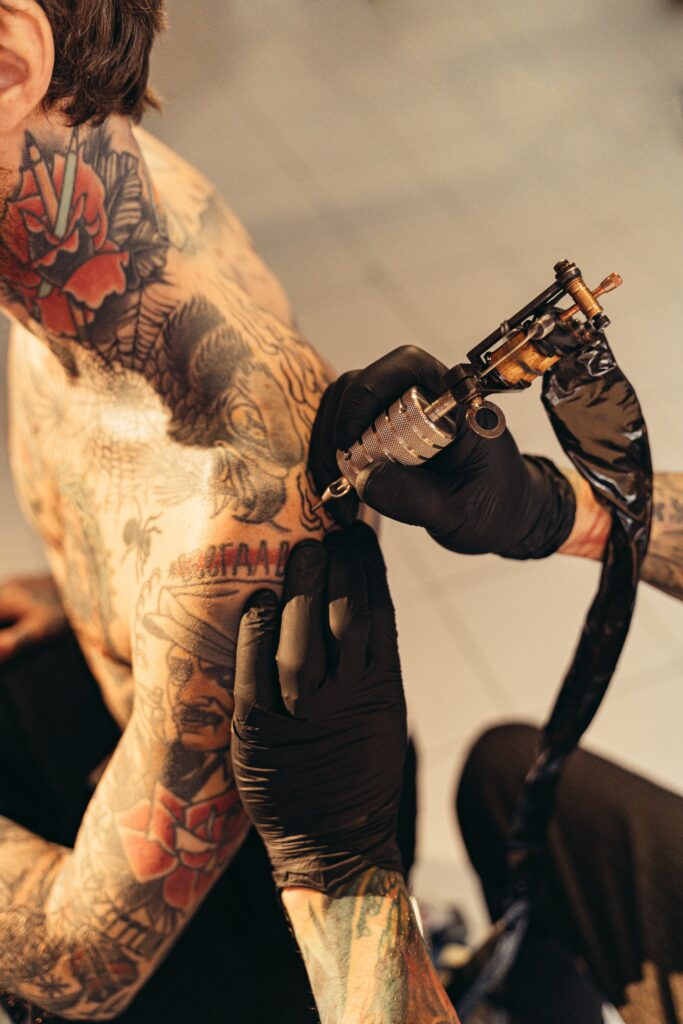
Planning is not just about the design, it’s also about choosing the right artist, understanding your pain threshold, and a myriad of other aspects. Here’s a helpful checklist for your tattoo journey:
- Find your artist: Your design will evolve based on the artist you choose. Like chefs, each artist has their unique flavor. Choose someone whose style resonates with you and they are professional and approachable.
- Identify your style: From tribal to watercolor, new school to Celtic, there’s a smorgasbord of styles out there. Some artists specialize in specific styles and can bring out the best in them.
- Decide your theme: Do you want it to be gothic or fairy-tale-like, religious or music-oriented? This will form the base of your tattoo.
- Choose motifs: What do you want your tattoo to represent – love, death, dreams, faith?
- Pick symbols: Based on the style, theme, and message, select symbols to add depth to the design.
- Select a color palette: Do you want it in black and white, greyscale, or color?
- Discuss placement: Certain areas like the armpits, elbows, inner elbows, and wrists can be more sensitive. Plan accordingly.
- Plan with your artist: This should be a collaboration. Share your ideas and let them enrich it with their expertise.
Remember, planning can be fluid. You can start with a broad theme and add elements over time as you accumulate experiences or complete milestones. And never compromise on quality for the sake of cost. A good tattoo is a lifelong investment.

The Time Frame of Sleeve Tattoos
Average time required for an arm sleeve varies from 10 to 80 hours, depending on the complexity. It involves multiple sessions spread over weeks, months, or even years. Each session usually lasts three to six hours. And typically, there’s a two-week gap between sessions. Of course, this can change based on your body’s healing capacity and the artist’s availability. For instance, one of my clients, a tough-as-nails biker, and I managed a whopping 16-hour session! Quite an ink-credible feat, I must say!
Now, you are equipped with essential knowledge to embark on your sleeve tattoo journey. Remember, it’s an adventure, unique to you. Embrace the process, and you’ll wear an art piece that narrates your story.
Is the Pain Tolerable?
I often get asked, “Does a sleeve tattoo hurt?” Well, the answer is a little more complicated than a simple yes or no. Everyone’s pain threshold is different. I remember my friend Jake, who said that his full sleeve tattoo felt like a cat scratch, while Sarah compared her quarter sleeve to a constant bee sting. In general, you’re likely to feel more discomfort around the elbow, inner elbow, wrist, and armpit area.
I’ve learned a few tricks over the years to manage the pain. One of my favorites is the ‘distraction technique.’ Put on your favorite show, or lose yourself in a gripping audiobook. And remember, your arm might feel numb for a while, but that’s okay – it’s all part of the process!
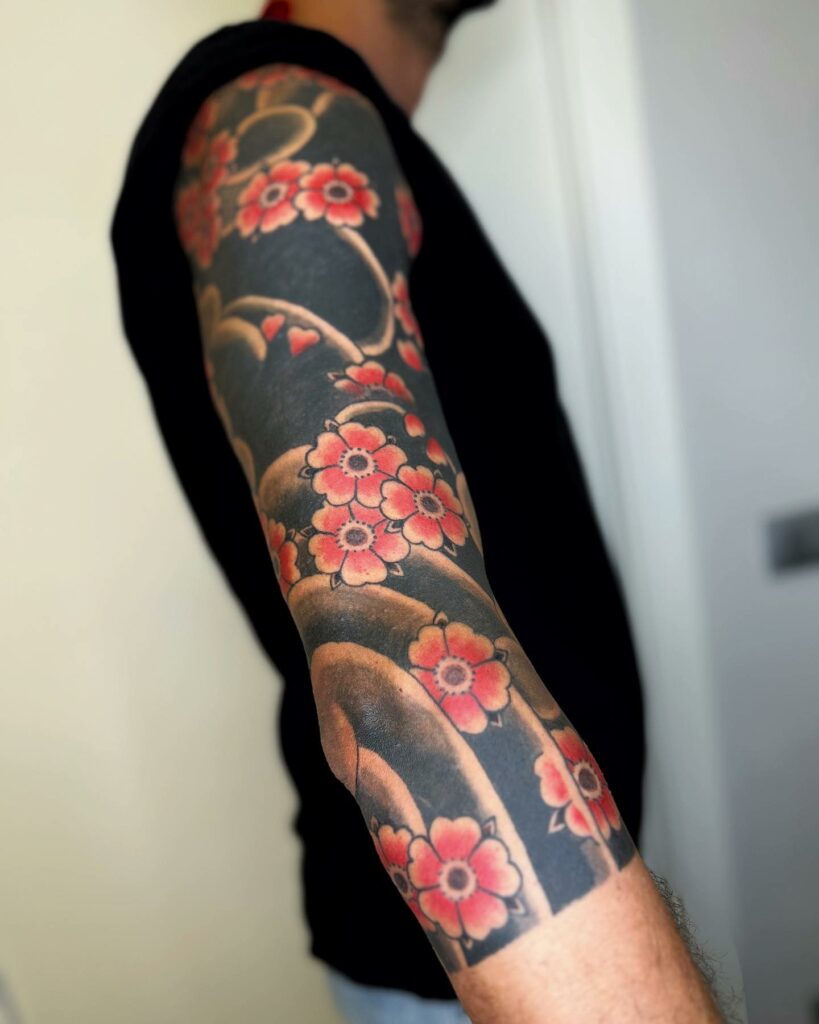
How Much Do Sleeve Tattoos Cost?
Just as no two snowflakes are the same, sleeve tattoos’ cost varies greatly depending on the design’s complexity and the time it takes. Let’s look at a rough breakdown:
- Full Sleeve: Expect a minimum of 10 to 15 hours, and typically, it costs about $1,500. But don’t be surprised if a more intricate, colorful design takes around 40 hours and up to $4,000.
- Half and Quarter Sleeve: These smaller stories take roughly five to eight hours, costing around $500 to $2,000 on average.
Let me share a story from my own experience. I remember a client, a fervent music enthusiast. He wanted a full sleeve tattoo representing his favorite bands – each in their unique art style. It was one of the most detailed designs I’ve worked on and took nearly 40 hours to complete. But his joy and satisfaction made it worth every minute. Remember that these are average costs and can vary based on factors such as the artist’s rate, the complexity and color of the design, and your location.
| Tattoo Type | Average Minimum Hours | Average Cost |
|---|---|---|
| Full Sleeve | 10-15 Hours | $1,500-$2,500 (up to $4,000+ for intricate designs) |
| Half Sleeve | 5-8 Hours | $500-$2,000 |
| Quarter Sleeve | 2-4 Hours | $200-$800 |
A Canvas Unlike Any Other
What makes a sleeve tattoo so special and why does it cost as much as it does? Unlike a flat canvas, an arm has contours and complexities. The design must adapt and flow with these natural curves. It’s a four-dimensional artwork covering the upper outer shoulder, inner upper arm, inner forearm, and outer forearm. This complexity contributes to both the time and cost. But the final masterpiece? Worth every penny and every second!

What Is the Process Like?
I always compare getting a tattoo to a shared adventure between the artist and the client. Let me walk you through the stages:
- After you settle on a design, I’ll measure your arm to ensure the art fits just right.
- In the first session, I’ll ink the outline. It’s like sketching the foundation of a beautiful building.
- Next, we’ll move on to the shading and details. This is where the story truly starts to unfold.
- Finally, we’ll add color and finishing touches, bringing your vision to life!
This journey often stretches across several months, with each session lasting an average of three to five hours. But remember, this schedule is flexible, so we can plan around your commitments.
Healing Process
Taking care of your new ink is just as important as the process of getting it. I can’t stress enough how vital this is, especially with a sleeve tattoo where you’re returning for multiple sessions. I’ve seen a rushed healing process cause complications, which prolongs the overall timeline and could increase costs.
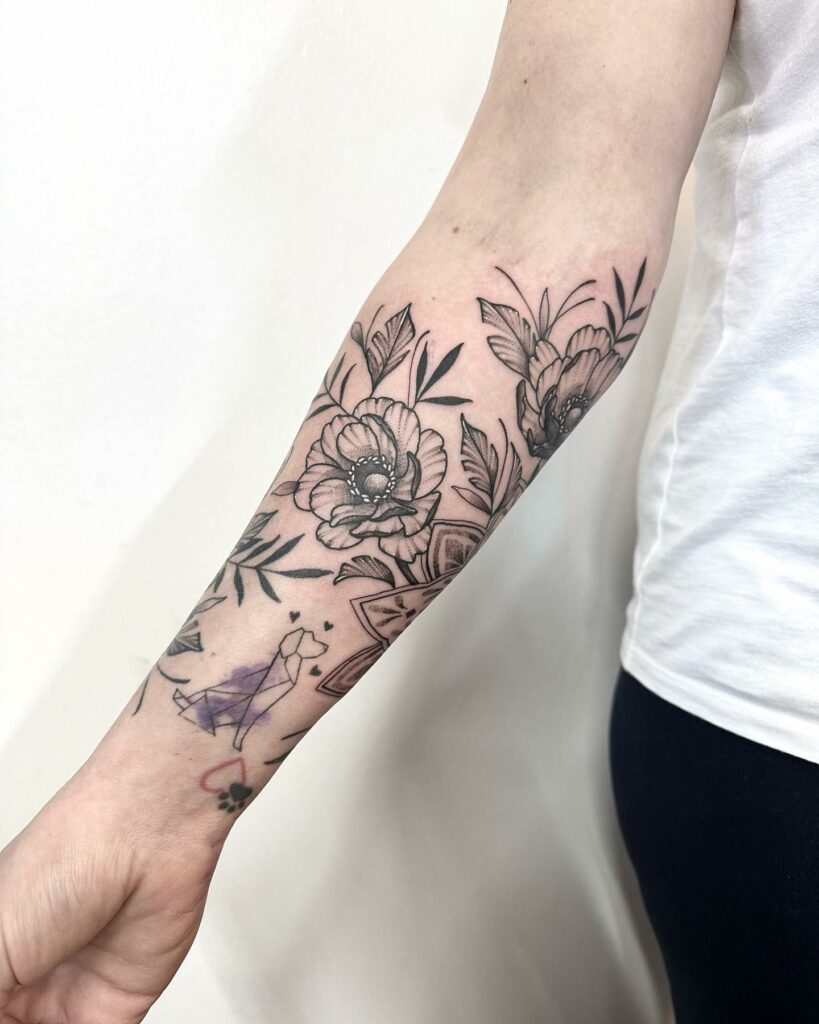
Aftercare Instructions
- Keep the bandage on for a few hours post-session.
- Wash the area gently with antibacterial soap and pat dry.
- Let it breathe for about 10 minutes, then apply a thin layer of lotion.
- Continue this washing and moisturizing routine two to three times a day until your skin finishes peeling.
Remember, peeling and some ink traces falling off is normal. But if your tattoo doesn’t heal before the next session, we might need to reschedule. So follow these instructions religiously to expedite healing and prevent scabbing.
Is Bleeding Normal?
Some bleeding during the first two nights after a fresh tattoo is normal, as is mild redness and swelling in the first week. What’s not normal is pus, a foul odor, or extreme swelling and inflammation that continues for more than a week. If you notice any of these, reach out to your doctor or tattoo studio immediately.
8 Things to Avoid After Getting a Sleeve Tattoo

Here are eight golden rules to protect your new ink:
- Resist the urge to pick at scabs or peeling skin.
- Apply lotion in thin layers to let your skin breathe.
- Avoid baths and swimming to prevent prolonged water exposure.
- Keep showers quick and lukewarm. Hot steam and moisture aren’t your tattoo’s friends.
- Don’t sleep on your tattooed arm. It needs oxygen, and your ink needs to avoid your sheets.
- Steer clear of tight-fitting clothes. Your tattoo needs to breathe.
- Shield your tattoo from direct sunlight, which can cause scarring and uneven healing.
- Skip the tanning bed. It’s as harmful as direct sunlight.
So there you have it, your guide to navigating the vast and exciting territory of sleeve tattoos. Remember, this journey is a collaboration, a shared adventure. Embrace the process, and soon, you’ll wear your unique story on your sleeve!
Aftercare For A Sleeve Tattoo?
he aftercare process for a sleeve tattoo is a critical aspect of ensuring that your tattoo heals properly and looks its best. It’s essentially the same as for any other tattoo, but as sleeve tattoos are larger, they require diligent care. Here are the steps you generally need to follow:
- Keep the Bandage On: The tattoo artist will cover your tattoo with a bandage after they finish. It’s important to leave this on for a few hours to protect the skin and allow it to begin healing.
- Clean the Tattoo: After removing the bandage, gently clean the tattooed area with warm water and mild, fragrance-free soap. Avoid using a washcloth or anything abrasive. Pat the area dry with a clean towel.
- Apply Lotion: Once the tattoo is clean and dry, apply a thin layer of a recommended tattoo lotion or ointment to keep the skin moisturized. Avoid using products that contain alcohol or fragrances, as these can cause irritation.
- Repeat Cleaning and Moisturizing: You should continue washing and moisturizing the tattooed area two to three times a day until the skin finishes peeling, which usually takes about two to three weeks.
- Avoid Sun Exposure: Keep your tattoo out of direct sunlight to prevent fading. If you have to be outside, make sure the tattoo is covered with clothing.
- Avoid Water: During the healing process, avoid swimming or soaking in water, as this can damage the tattoo.
- Don’t Pick at Scabs: As your tattoo heals, it will scab and peel, much like a sunburn. Do not pick at the scabs or peel the skin, as this can pull out the ink and lead to patchy healing.
- Wear Loose Clothing: Make sure the clothing around your tattoo is loose and breathable, to allow the tattoo to breathe and help prevent infection.
- Monitor for Infection: Look out for signs of infection, like excessive redness, swelling, or pus. If you suspect your tattoo may be infected, contact your healthcare provider or tattoo artist right away.
Remember, the healing process can take up to a few weeks, and the longevity and look of your tattoo depend on how well you care for it during this time.
Conclusion
Embarking on the journey of getting a sleeve tattoo is an exciting adventure, filled with creativity, anticipation, and yes, a bit of discomfort. However, remember that the pain is temporary, but the art is permanent. As your guide through this process, I encourage you to take your time, thoroughly research your design, and choose an artist you trust and feel comfortable with. Be aware that the process is time-consuming and requires an investment, but the result is a unique piece of art that you get to carry with you forever.
It’s crucial to care for your new tattoo properly to prevent complications and ensure the best outcome. Good aftercare can make the difference between a tattoo you love and a tattoo that requires touch-ups or even worse, medical attention.
Lastly, remember that everyone’s tattoo experience is unique. Embrace the journey, and don’t forget to enjoy the process. After all, you’re crafting a story on your skin, a narrative that’s deeply personal and utterly unique. So go ahead, turn that ink-filled dream into a reality. Your sleeve masterpiece awaits!




